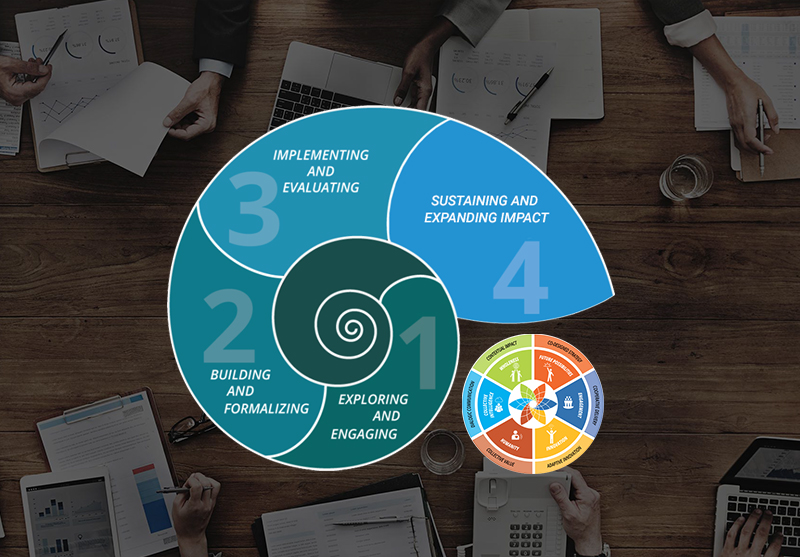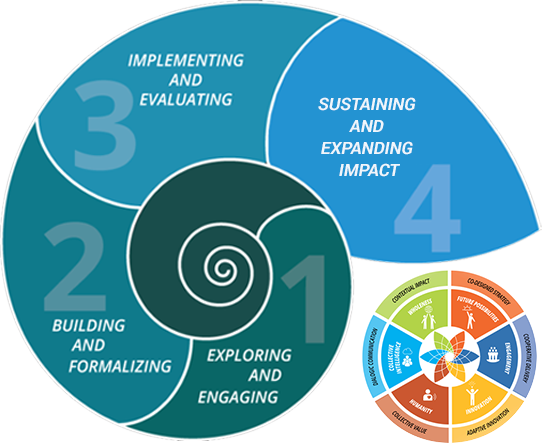Collaboration ecosystems thrive and deliver impact when they are supported by a coherent process architecture with co-creative stakeholder events.
The quality design of events and processes helps stakeholder to engage with each other and commit to drive change together. Stakeholders often have different opinions and world views, or, at times, standpoints that may even be controversial. High quality process architectures keep the complex set of actors within an overall frame of collective action that everybody understands. They help to prevent chaos, but allow diverse perspective and approaches to emerge.
This means paying careful attention to engagement and communication, to relationship building and interaction among stakeholders. The Dialogic Change Model provides guidance for developing such step-by-step process architectures in the four phases of collaborative change. Key questions inspired by the Collective Leadership Compass provide a quality check for good process design in each of the phases.
Process architectures show
For example: sequences of inspiring conversations, feasibility studies, stakeholder interviews, sensing journeys, informal discussions, stakeholder meetings or workshops, planning events, strategic review events, general communication, monitoring procedures, etc.
For example: International, regional, local change processes or separate processes with different stakeholder groups and how they are gradually brought together, etc.
For example: Overarching meetings, stakeholder learning conferences, embedding the process in other international initiatives, etc.
For example: The relationship between implementation and campaigns, capacity building and implementation, or knowledge building and advocacy, etc.

High-quality process architectures and co-creative events are important in all four phases of dialogic change.
In phase 1 of Exploring and Engaging it is important to build trust and resonance for change, so that a core group (Container) can form and begin to drive the further process. Meetings need to be designed in a way that they build trust and a sense ownership.
In phase 2 of Building and Formalizing it is important that all stakeholders know what the next steps are and how joint planning will take place. Stakeholder meetings and events need to allow for joint situation analysis and co-design of change strategies.
In phase 3 of Implementing and Evaluating the reliability of communication, transparency and complementary delivery is key. Stakeholder meetings need to encourage joint learning and celebration of progress.
In phase 4 of Sustaining and Expanding Impact it is paramount to create transparent planning processes for scaling impact. Stakeholder meetings need to encourage exploration of future strategies and build a culture of learning into governance and steering structures.

The Compass can be used as a lens to look at the patterns in the stakeholder system. This helps to identify entry points for collaborative change.
When you use the Compass remember that the purpose is to enliven the collaboration pattern to achieve better results.
Designing change processes is an ongoing task in stakeholder initiatives throughout all four phases. Collaboration ecosystems move between structured conversations, finding agreements how to move forward and implementing expected results. The Collective Leadership Compass is a faithful navigating tool helping to keep the six dimensions in an appropriate balance. Developing process competence is key for making collaborative change work for all.
Below you can find essential knowledge building background information that help you to become an expert on process design.
Working with key principles for process designs in the four phases of collaborative change helps to create process architectures that make collaboration work. Successful transformative change requires process competence.
Building small to large containers for change is the most important ingredient for ensuring that change will really happen. Good containers are the only guarantee for successful collaborative change.
Collaborative change requires sufficient structures that hold the collaboration ecosystem together and help people to work on concrete results. Governance creates trust, if set-up in the right way. Implementation management ensures delivery.
DOWNLOAD FACTSHEET 3 ON GOVERNANCE AND IMPLEMENTATION STRUCTURES
Backbone support refers to funded staff resources that provide ongoing support to the process management of the collaborative change initiative. They are experts in designing process architectures and facilitate the co-development of emotionally compelling goals, strategies and implementations plans.
Managing difficulties and conflicts are normal side-effects of collaborative change. Yet, disagreements and misunderstandings can complicate implementation. Many difficulties can be prevented by applying careful planning and adhering to the principles of high-quality process architectures.
The “Theory of Change” (ToC) describes how actors in collaborative change initiatives expect that impact to happen. This helps stakeholders to jointly see how collaboratively planned activities lead to the desired goals.
Designing meaningful meetings that enhance dialogue and collective action need to be built on the collective intelligence of people while harvesting differences and acknowledging expertise. High quality stakeholder meetings and events are paramount for each of the four phases of collaborative change. Structured dialogue is the cornerstone of high-quality process architectures. The Collective Leadership Compass is an inspiring quality check helping to keep the six dimensions in an appropriate balance. Developing dialogic competence is key for making collaborative change work for all.
Below you can find essential knowledge building background information that help you to become an expert on dialogue and co-creative stakeholder events.
Not all meetings bring a sense of aliveness, do-ability and commitment for change into a group of people. The way meetings, workshops, structured dialogue, or large public stakeholder events must follow a few simple principles for making dialogue and collaboration work.
Not every conversation between different stakeholders stays constructive and leads to a joint result. Being able to identify unhelpful communication patterns is an important step to improvement. Understanding the conditions for generative dialogue to emerge is a key ingredient for collaborative change.
Collaboration initiatives bring actors with different perspectives and diverging interests together. Structured listening to the concerns of different stakeholders is key. Dialogic competence means understanding when advocacy is needed and when inquiry will move the conversation forward.
DOWNLOAD FACTSHEET 9 ON DIALOGIC COMPETENCE
The physical setting of meetings has a decisive influence on the results of a conversation between stakeholders. The structure of a seating order often determines to a great extent the way people communicate with each other. Getting the space right is paramount for co-creative events.
Transformative change in multi-stakeholder collaboration is effective with structured engagement of all relevant actors and high quality process architectures The Dialogic Change Model is a process methodology that allows for the result- oriented planning and implementation of collaborative change.
It is based on 25 years of experiences in support of multi-stakeholder processes and combines ancient human dialogue knowledge with modern approaches to co-creation and collective intelligence. It structures the design and implementation of transformative change into four distinct phases that help actors apply the Collective Leadership Compass in the most effective way.
LEARN MORE AND DO A READINESS CHECK